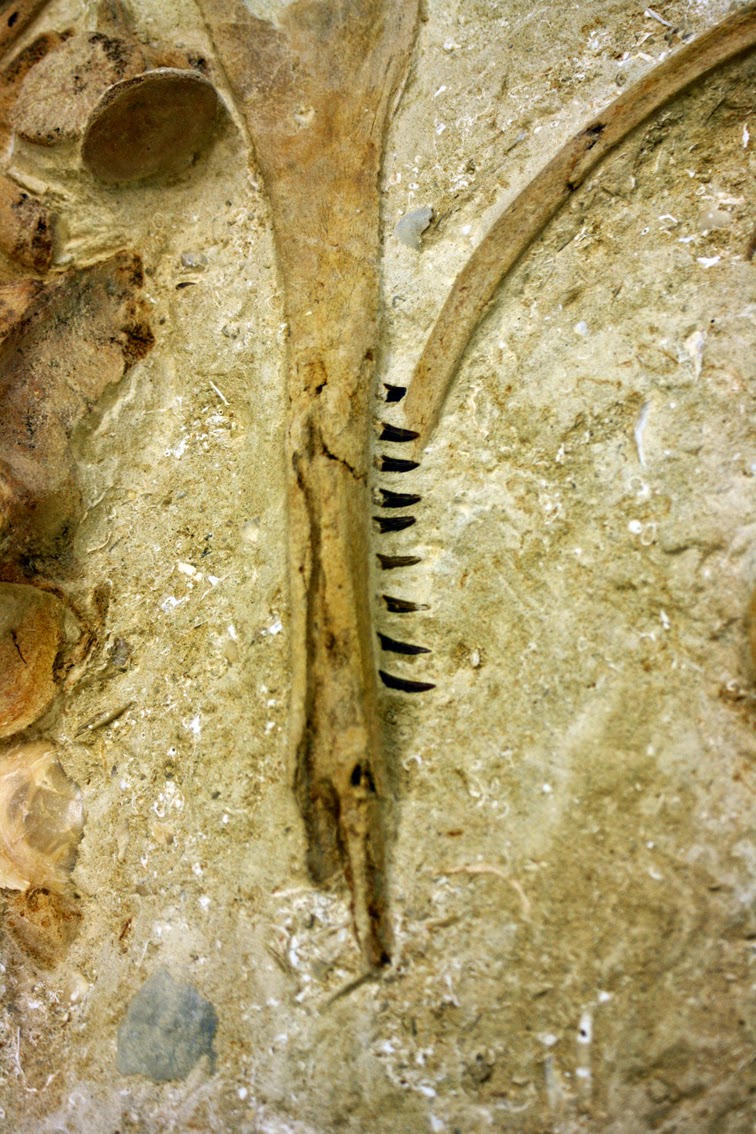Here's a view of the skull and mandible; the gray pieces at the upper right are parts of a large echinoid.
And a mandible with numerous in situ teeth - with the exception of a handful of specimens, most fossil odontocetes in the Otekaike Limestone have teeth that are mostly disarticulated.
And the skull has quite a nice dentition as well! Unfortunately, the tip of the rostrum is missing.
Here it is with a little more preparation. The teeth are quite a bit narrower and more needle-like than other Otekaike Limestone odontocetes.
Here's some nice postcrania...
And more teeth; a single tooth resembles Microcetus hectori (a taxon currently being redescribed by Yoshi Tanaka). There are some tusk-like teeth that were found loose - almost all of the Oligocene odontocetes from NZ appear to have had procumbent tusk-like anterior teeth. Provisionally the skull is similar to odontocetes that have been identified previously as "dalpiazinids". It should be a beauty when preparation is done!







This comment has been removed by the author.
ReplyDeleteWow! What a pretty well-preserved dolphin. With respect to Dalpiazina, I have a feeling that Dalpiazina should be included in the data matrices of the cladistic analyses of fossil platanistoids by Barnes (2006) and Barnes and Reynolds (2009) to see if Dalpiazinidae is a distinct family or falls within one of the existing groups of non-squalodont platanistoids (like say, Allodelphinidae). I'm aware of the fact that Microcetus hectori is not in the same genus as Microcetus (a possible waipatiid) and is instead a squalodelphinid. It'd be interesting to see if Tanaka will rename M. hectori as Uncamentodon b/c Rothausen recognized the generic distinctness of Microcetus ambiguus and M. hectori.
ReplyDeleteThe type specimen of Dalpiazina is too incomplete to be coded.
ReplyDeleteI'm afraid I cannot say anything more about M. hectori, only that a manuscript redescribing M. hectori by my labmate Yoshi is nearing completion and submission.
Regarding the NZ "dalpiazinids", these will likely be the subject of a future Ph.D. dissertation.
Hi Bob,
ReplyDeleteThe redescription of Microcetus hectori is out --- see the link for more info:
Y. Tanaka and R. E. Fordyce. 2015. Historically significant late Oligocene dolphin Microcetus hectori Benham 1935: a new species of Waipatia (Platanistoidea). Journal of the Royal Society of New Zealand
As with Otekaikea, the waipatiid classification of M. hectori is also surprising because M. hectori was considered a squalodelphinid by Fordyce (1994). Moreover, Tanaka and Fordyce report remains of Waipatia from Oligocene deposits in northern Libya, meaning that Waipatiidae is now a global clade.
Yup, as Yoshi's labmate the Waipatia hectori holotype sat in our office, literally adjacent to my desk for about a year or so. I'm happy to see Yoshi's careful work published at last.
ReplyDeleteIt's perhaps not that surprising, as few authors have been able to really give a meaningful definition of what exactly a squalodelphinid is.
I'm not sure where you got the idea that they report remains of Waipatia from Libya; there is no mention of Libya or Africa within their paper. Bianucci et al. 2011 reported possible waipatiids from the Oligo-Miocene of Malta, and "Microcetus" has been reported from the Oligocene of Germany (M. ambiguus) and Kazakhstan (M. sharkovi), which are phenetically somewhat similar but plot out cladistically outside of Waipatiidae and at present cannot be confidently regarded as waipatiids.